Physical Address
304 North Cardinal St.
Dorchester Center, MA 02124
Pregnancy increases cardiac output and intravascular volume, which increases gradients across stenotic lesions and can exacerbate heart failure in patients with severe valvular stenosis.
Intravascular volume increases in the immediate postpartum period, and high-risk patients require 48 to 72 hours of close monitoring after delivery.
The risk of cardiovascular events ranges between 5% and 70% for women with heart disease. Women with higher New York Heart Association class, mitral or aortic stenosis, mechanical valves, pulmonary hypertension, or multiple lesions are at highest risk.
Women at increased risk for adverse maternal or fetal outcomes should be referred to experienced centers.
Vaginal delivery is safe for most patients with cardiac lesions. In most cases, cesarean section should be reserved for obstetric indications.
For women with mechanical valves, meticulous uninterrupted anticoagulation is essential, but morbidity rates remain elevated for this population. Warfarin is recommended for most women in the second and third trimesters despite higher fetal risk. However, the anticoagulation strategy needs to be individualized for each patient.
Although pregnancy is typically safe in developed countries, women with cardiac disease have 100 times greater risk of dying during pregnancy than women without heart disease. Accurate risk assessment, prenatal counseling, and a multidisciplinary approach during pregnancy and in the peripartum period are therefore critical.
Valvular heart disease in pregnant women includes those with known valve disease who come in before pregnancy for evaluation of potential maternal and fetal risk; women with known valve disease who come in during pregnancy without preconception counseling; and women without known cardiac disease who are diagnosed during pregnancy. In each situation, the normal physiologic changes of pregnancy may exacerbate the hemodynamics of the valve lesion, and women who are asymptomatic in the nongravid state may decompensate during pregnancy.
Management is complicated by the potential effects of medication, irradiation, or surgery on the fetus. Despite increased maternal and fetal risks, most women with valvular heart disease can successfully complete pregnancy with careful management by a multidisciplinary team at an experienced center.
During pregnancy, there are substantial increases in plasma volume, erythrocyte volume, and cardiac output ( Fig. 28.1 ). Cardiac output increases by up to 45%, mostly due to a 20% to 30% increase in heart rate. There is a smaller increase in stroke volume. The increase in cardiac output begins as early as 10 weeks of gestation, with the maximal cardiac output achieved in most by 24 weeks ( Fig. 28.2 ). , , Pulmonary pressures should remain normal during pregnancy because there is a decrease in pulmonary vascular resistance through vascular recruitment in the high-capacitance pulmonary circulation. Left ventricular (LV) filling pressures also should remain normal.
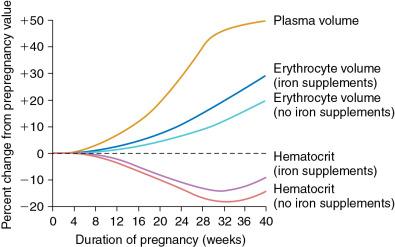
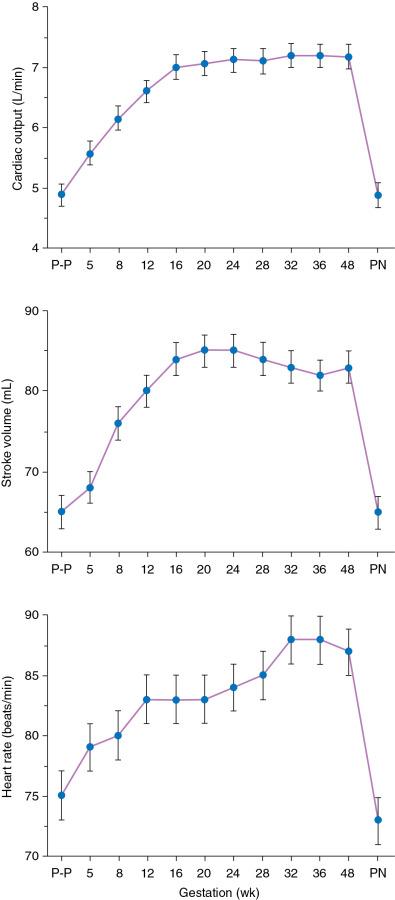
During pregnancy, an increase in venous tone augments preload while a decrease in aortic stiffness and alterations in the microcirculation reduce afterload. The decrease in systemic vascular resistance offsets the increase in cardiac output so that blood pressure decreases slightly during pregnancy. LV wall stress decreases by about 30%, reducing the oxygen demand of the myocardium. , Several studies have suggested that LV contractility may be mildly depressed, although the magnitude of this change is unlikely to be clinically significant. , , Stroke volume is maintained in the setting of decreased contractility by the altered loading conditions of pregnancy. At term, the relationship between LV filling pressure and stroke-work index is comparable to that in the nonpregnant state.
The effects of positional change on hemodynamics may be more prominent in women with valve disease. In the supine position, the gravid uterus can compress the inferior vena cava, resulting in decreased preload, stroke volume, and cardiac output. This can be avoided by use of the left lateral decubitus position. Some patients may also need to labor in the left lateral decubitus position to maintain cardiac output.
Peripartum hemodynamics is affected by uterine contractions, the pain of labor and delivery, and blood loss. Pain increases heart rate, blood pressure, and stroke volume. Uterine contractions reintroduce blood into the circulating blood pool. The increase in intravascular volume with each contraction is accompanied by an increase in heart rate, and cardiac output is augmented by about 20% during each contraction ( Fig. 28.3 ). In the setting of valvular disease, these hemodynamic alterations may result in clinical deterioration. , Labor and delivery are associated with mild increases in LV diastolic pressure, which may lead to pulmonary edema in a patient with decreased LV compliance. The increase in intravascular volume that occurs with uterine contraction can increase LV end-diastolic pressure and pulmonary edema.
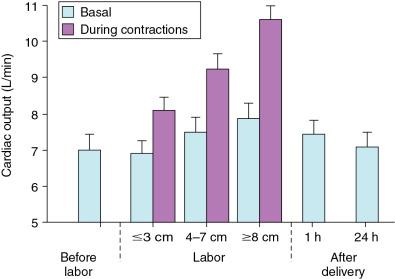
Blood loss from vaginal delivery partially compensates for the increased blood volume of pregnancy, but acute changes may not be well tolerated by women with valvular heart disease. This is particularly true when the LV diastolic pressure-volume relationship is very steep, as in women with severe aortic stenosis (AS): a small loss of volume and preload may result in a large fall in cardiac output. However, the volume changes with cesarean section are even greater than with vaginal delivery. , Cesarean section is rarely indicated for cardiac reasons.
After delivery of the placenta, stroke volume and cardiac output rise by about 10% and remain elevated for approximately 24 hours. Over the next 2 weeks, cardiac output declines by 25% to 30%, related to decreases in heart rate and intravascular volume , ( Fig. 28.4 ). In some patients, symptoms occur after delivery because of intravascular and extravascular volume shifts that result in spontaneous volume loading. , Although hemodynamics return toward baseline by 6 to 12 weeks after delivery, the new postpartum baseline may be different from the prepregnancy state. For example, LV and aortic dimensions may remain slightly larger than at baseline. ,
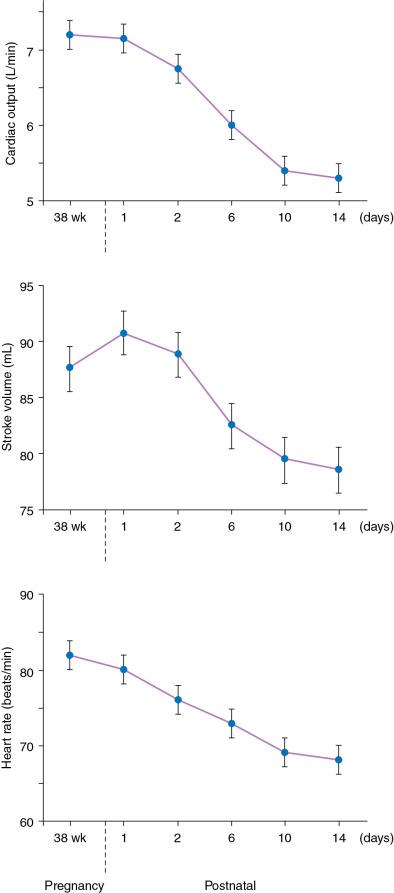
Echocardiographic findings reflect the normal physiologic changes of pregnancy. LV end-diastolic diameter increases by 2 to 3 mm, with no change in the end-systolic dimension, and fractional shortening and ejection fraction are increased compared with baseline values. The aortic root and LV outflow tract diameters increase by 1 to 2 mm, and this increase often persists after pregnancy. , Left atrial area increases by about 2 cm 2 , in association with an increase in serum atrial natriuretic peptide levels. , There is a small increase in mitral annulus diameter and a larger increase in tricuspid annulus diameter. A small pericardial effusion is seen in 25% of healthy women during pregnancy.
The increased cardiac output of pregnancy leads to increased transvalvular flow velocities. Aortic and LV outflow velocities increase by about 0.3 m/s. The peak transmitral early ventricular filling (E) velocity increases by up to 0.1 m/s, and the late diastolic filling (A) velocity, which reflects atrial contraction, increases by 0.1 to 0.2 m/s. , The greater increase in A velocity compared with E velocity results in a shift from the normal E/A ratio seen in young adults to an equalized or reversed E/A ratio. The pulmonary venous flow pattern shows an increase in velocity, but not in duration, of the pulmonary venous A wave. For these reasons, pregnant women can appear to have diastolic dysfunction on echocardiography.
Mild tricuspid and pulmonic regurgitation are common during pregnancy, as is physiologic mitral regurgitation (MR), which is most likely to be caused by annular dilation. Gradients across native and prosthetic valves increase in pregnancy due to increased flow and increased heart rate. Changes seen with specific cardiac lesions are discussed later.
The incidence of rheumatic heart disease has declined in industrialized nations over the past 40 years. , During that same period, there has been an increase in the number of adults with congenital heart disease. Other causes of valve disease, including connective tissue disorders such as Marfan syndrome, are increasingly recognized in pregnancy. Although rheumatic heart disease remains common among pregnant women in economically developing countries, congenital and genetic valvulopathies are more common in industrialized nations.
Patients with congenital or genetic valve disease frequently have additional associated cardiovascular abnormalities. Some patients have a systemic right ventricle or aortic pathology that introduces additive risk. The spectrum of valve disease in pregnancy makes risk assessment somewhat difficult, but general risk factors and risks based on specific valvular lesions can be identified.
The European Society of Cardiology (ESC) has created the Registry on Pregnancy and Cardiac Disease (ROPAC) and prospectively enrolled more than 1300 pregnant women with heart disease. Among the enrollees with valvular heart disease, the maternal mortality rate was 2.1%, and the hospitalization rate was 38%. This may be an overestimate for North American and European centers because the majority of deaths occurred among women in low-resource countries. Risk is not increased uniformly for all pregnant women with valve disease. Accurate identification of risk factors for adverse outcomes allows preconception counseling and decisions about appropriate monitoring during pregnancy.
A multicenter Canadian study of Cardiac Disease in Pregnancy (CARPREG) prospectively enrolled consecutive pregnant women with all types of heart disease. Predictors of adverse maternal events were a history of cardiac events before pregnancy, New York Heart Association (NYHA) functional class greater than II, cyanosis, left heart obstruction, and systemic ventricular dysfunction. These factors allowed prediction of the risk of maternal events ( Table 28.1 ; Fig. 28.5 ). , In this series, the live birth rate was 98%. Maternal risk factors for fetal or neonatal death are listed in Box 28.1 . Adverse neonatal events occurred in 20% of pregnancies, including premature birth in 18% and small-for-gestational-age birth weight in 4% of pregnancies. Among the infants of women who had a congenital heart disease but not a recognized genetic syndrome, 7% had congenital heart disease.
| Predictors of Adverse Maternal Events in CARPREG | |
|
|
|
|
|
|
|
|
| CARPREG risk score: for each CARPREG predictor that is found, a point is assigned. Risk estimation of maternal cardiovascular complications: 0 points, 5%; 1 point, 27%; >1 point, 75%. | |
| Predictors of Adverse Maternal Events in CARPREG II | |
|
3 points |
|
3 points |
|
3 points |
|
2 points |
|
2 points |
|
2 points |
|
2 points |
|
2 points |
|
1 point |
|
1 point |
| CARPREG II risk score: risk estimation of maternal cardiovascular complications: 0–1 points, 5%; 2 points, 10%; 3 points, 15%; 4 points, 22%; >4 points, 41%. | |
| Predictors of Adverse Maternal Events in ZAHARA | |
|
|
|
|
|
|
|
|
|
|
|
|
|
|
|
|

Predictors of adverse fetal events
Cyanosis , ,
NYHA functional class > II
Left heart obstruction ,
Smoking , ,
Anticoagulation
Multiple gestations ,
Arrhythmia
Cardiac medications before pregnancy
Mechanical heart valve
In this same study population, 302 pregnancies of women with heart disease were compared with 575 pregnancies of women without heart disease. The rate of maternal cardiac complications was 17% among women with heart disease and 0% in the control group. Heart failure and arrhythmias accounted for most of the cardiac complications (94%). There were two postpartum maternal deaths due to heart failure or pulmonary hypertension. The risk of neonatal complications was 2.3 times normal ( Fig. 28.6 ). The additive effects of maternal cardiac and obstetric risk factors support referral of patients with these conditions to high-risk obstetric clinics (see Fig. 28.5 ).
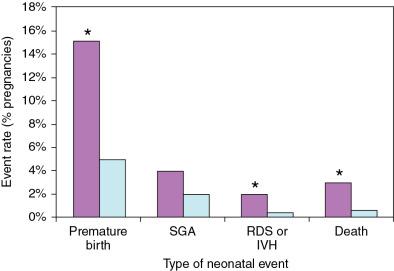
The CARPREG study was updated in 2018 in CARPREG II, a prospective study of 1938 pregnancies in women with cardiovascular disease, approximately two thirds of whom had congenital heart disease. On multivariable analysis, 10 clinical predictors of adverse maternal events were identified. Each score was weighted, and a new CAPREG score was developed (see Table 28.1 ). The strongest predictors of adverse events were prior cardiac events, baseline NHYA class III or higher, cyanosis, and presence of a mechanical heart valve. Other multivariable predictors of adverse outcomes included ventricular dysfunction, left-sided obstructive lesions, pulmonary hypertension, coronary artery disease, aortopathy, no prior cardiac intervention, and late pregnancy assessment ( Fig. 28.7 ).
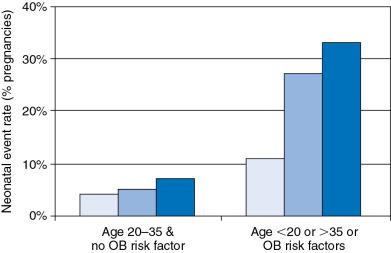
In another study of 1302 pregnancies of women with congenital heart disease (ZAHARA), the overall rate of maternal complications was 7.6%. The strongest predictors of adverse maternal events were presence of a mechanical valve, mitral stenosis (MS) or AS, NYHA class greater than II, a history of arrhythmia, and need for cardiac medications before pregnancy. Risk factors were additive, and women with more than one risk factor had a greater than 18% risk of a maternal complication during pregnancy (see Table 28.1 ).
Using results from published risk models and expert opinion, the World Health Organization (WHO) developed a consensus-based document to risk-stratify women with cardiovascular disease into four categories ( Box 28.2 ). The WHO risk I category designates women with no perceived increased risk, such as those with mitral valve prolapse or repaired ventricular septal defect. Pregnancy is contraindicated in women with WHO risk IV lesions, such as those with severe symptomatic AS or MS and women with pulmonary arterial hypertension. Although the WHO criteria are derived from expert consensus, they have outperformed CARPREG and ZAHARA in their ability to predict risk ( Fig. 28.8 ). The ESC recommends that maternal risk assessment be performed with regard to the WHO risk classification.
WHO risk I: No detectable increased risk of maternal mortality and no or only mild increase in morbidity
Uncomplicated, small or mild pulmonary stenosis, patent ductus arteriosus, or mitral valve prolapse
Successfully repaired simple lesions (atrial or ventricular septal defect, patent ductus arteriosus, anomalous pulmonary venous drainage)
Isolated atrial or ventricular ectopic beats
WHO risk II: Small increased risk of maternal mortality or moderate increase in morbidity
Unrepaired atrial or ventricular septal defect
Repaired tetralogy of Fallot
WHO risk II or III (depending on the individual)
Mild LV impairment
Native or tissue valvular heart disease not considered WHO I or IV
Marfan syndrome without aortic dilation
Aorta < 45 mm associated with bicuspid aortic valve
Repaired aortic coarctation
WHO risk III: Significantly increased risk of maternal mortality or severe morbidity; expert counseling is required. If pregnancy is decided on, intensive specialist cardiac and obstetric monitoring is needed throughout pregnancy, childbirth, and the puerperium.
Mechanical heart valve
Systemic right ventricle
Fontan circulation
Unrepaired cyanotic heart disease
Other complex congenital heart disease
Aortic dilation of 40–45 mm in Marfan syndrome
Aortic dilation of 45–50 mm in bicuspid aortic valve
WHO risk IV: Extremely high risk of maternal mortality or severe morbidity; pregnancy is contraindicated. If pregnancy occurs, termination should be discussed. If pregnancy continues, care as for class III.
Severe mitral stenosis, severe symptomatic aortic stenosis
Marfan syndrome with aorta dilated > 45 mm
Aortic dilatation > 50 mm in aortic disease associated with bicuspid aortic valve
Native severe coarctation
Pulmonary arterial hypertension of any cause
Severe systemic ventricular dysfunction (LVEF < 30%, NYHA class III–IV)
Previous peripartum cardiomyopathy with any residual impairment of left ventricular function
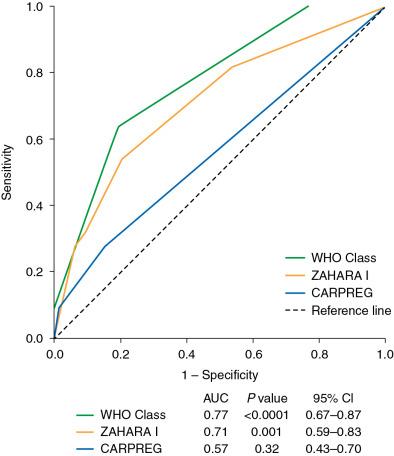
Aortic dilation occurs in women with bicuspid aortic valve, tetralogy of Fallot, transposition of the great vessels, or truncus arteriosus and in those who have undergone Ross repair for AS. The risk of aortic rupture or dissection during pregnancy is up to four times greater than at baseline.
Pregnancy increases the risk of dissection through several mechanisms: estrogen interferes with collagen deposition, elastase accelerates destruction of the elastic lamellae, and relaxin decreases collagen synthesis. , The risk of dissection in congenital abnormalities does not appear to be as high as the risk in genetic connective tissue disorders. The risk of dissection in women with bicuspid aortic valve appears to be greatest during the third trimester of gestation and at larger diameters, particularly larger than 45 mm (WHO risk III). , , Among patients with Marfan syndrome, the risk appears to be highest for those with aortic diameters larger than 40 mm.
These studies emphasize the importance of placing the valvular disease in the context of a patient’s other cardiac lesions because risk factors for adverse outcomes may be additive. Functional class is important in risk assessment, independent of the underlying hemodynamic abnormality.
Become a Clinical Tree membership for Full access and enjoy Unlimited articles
If you are a member. Log in here